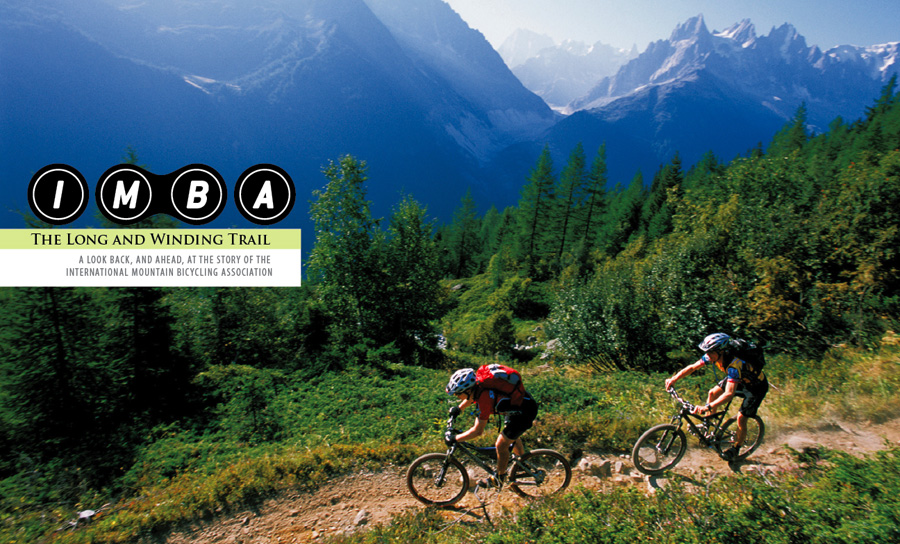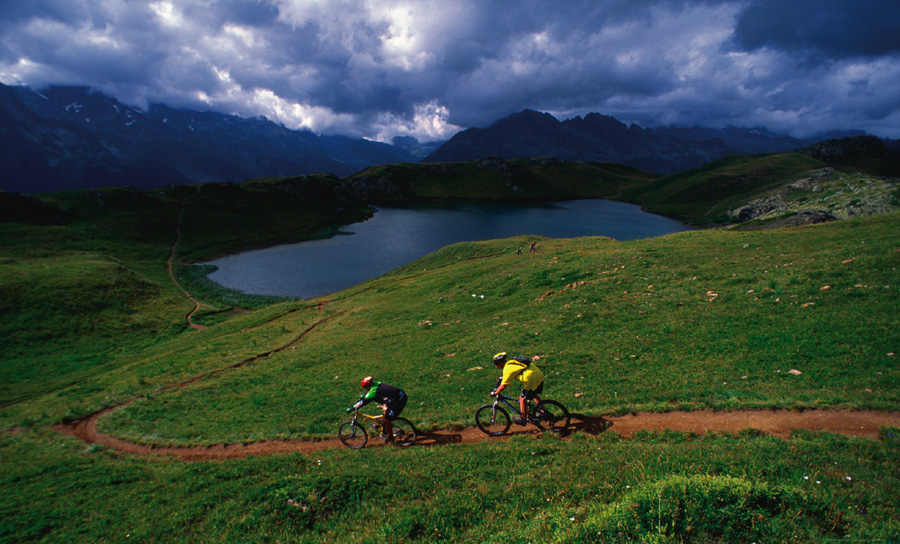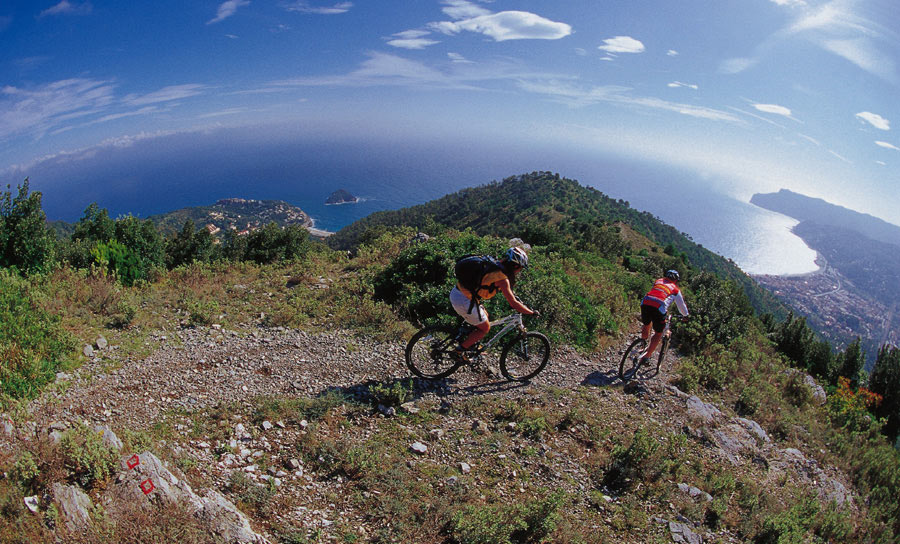



Taxonomy upgrade extras
A LOOK BACK, AND AHEAD, AT THE STORY OF THE INTERNATIONAL MOUNTAIN BICYCLING ASSOCIATION
Words by Mark Eller
Photos courtesy of IMBA
The world’s first bicycles were mountain bikes. Because very few roads were paved in the 19th century when bicycles were introduced in Europe and then in the U.S., they were usually ridden on dirt roads and trails.
Even in cycling’s early “golden years,” some people found bikes alarming, viewing them as contraptions that could scare horses and flatten pedestrians. They called on local officials to restrict or manage their use with laws setting speed limits, establishing traffic rules, and requiring illumination at night. By the mid-20th century, however, automobiles had replaced bicycles as the primary means of transportation in the developed world, and bikes were seen either as children’s toys or the odd fixation of adult enthusiasts. The management issues that accompanied them also faded into obscurity.
The Early Days of Mountain Biking
Bicycle management did not become a major issue again until the introduction of the modern mountain bike. In the mid-1970s, bicycle enthusiasts added gears and heavy-duty brakes to old paperboy-style bicycles in order to travel on the trails and dirt roads of undeveloped lands. In the early 1980’s, the first mass-produced mountain bikes became available, attracting existing bike enthusiasts and bringing legions of new riders to the sport. As the activity grew, so did questions of mountain bike management.
In the early days, hikers and equestrians tended to greet mountain bikers as amusing curiosities. They wanted to know all about the bikes, how far the rider had ridden, and how far they could ride. But that welcome soon wore thin. Some hikers and equestrians began to express concern about trail user safety. Some felt pushed off the trails by the presence of these new visitors. Some expressed concern about the impacts of bicycle use on the trails. People began to ask where bicycles might belong in the backcountry, and the issues fell to local land manager who were charged with protecting resources and regulating visitor activity.
Early Mountain Bike Management
The first attempts to manage mountain bikes usually involved some type of restriction. Most bicyclists presented themselves as legitimate, respectful visitors, more like “hikers with wheels” than “motorcyclists without motors” (early mountain bikers were likely to have been hikers who already embraced “leave-no-trace” ethics). However, there was also a large group of bike racers crossing over from the road or BMX tracks, who sometimes lent the sport a more aggressive, adrenalin-fueled image. That perception—and the simple presence of mechanical contraptions on the trails—raised significant concerns with both the public and with land managers.
In 1983, Boulder, Colorado, banned bikes from all trails and fire roads and in 1984, new U.S. Forest Service regulations banned bikes from federally-designated Wilderness areas. In 1986, East Bay Regional Parks in California banned bikes from trails, but allowed them on fire roads. This “fire roads yes, singletrack no” policy was quickly adopted by a number of other jurisdictions, and in 1989, it was institutionalized in system-wide California State Park policy. In 1988, the U.S. National Park Service enacted a very restrictive regulation that banned bikes entirely, unless they were specifically allowed by special regulation through a cumbersome process. This flurry of closures led bicyclists to organize.
The Birth of IMBA
In 1983, a group of avid U.S. mountain bikers founded NORBA, the National Off-Road Bicyclists Association, to regulate mountain biking competition and improve relations with land managers and other trail visitors. As competitive mountain biking took off, the organization began to focus more on racing, and it became clear that a separate advocacy organization was needed. In March 1988, five local clubs near population-pressured cities in California banded together to form the International Mountain Bicycling Association (IMBA).
IMBA was founded in the belief that organized, responsible mountain bikers could best collaborate with land managers and other trail users to manage and self-regulate the activity. IMBA’s founders felt that experienced riders could best educate newcomers about safe, responsible, and environmentally sound riding practices and influence other riders, manufacturers, event promoters, shops, and the mountain bike press.
In the coming years, IMBA would work with other bicycle advocacy groups, volunteers, and land managers to define the major issues of mountain bike management. They identified three general issues: public safety, environmental impacts, and user conflict. They were determined to demonstrate that these issues could be mitigated through careful planning and management. That basic assessment holds today.
IMBA Today
Mountain bicycling has become popular around the world, and most land managers and trail-user groups have come to acknowledge the legitimacy of responsible mountain bicycling on public lands. As acceptance of mountain biking has grown, many of the early blanket closures have been reversed, and regulations are now more site-specific and nuanced. There are currently a number of official partnerships between IMBA, IMBA-affiliated clubs, and land management agencies not only to promote mountain biking, but also to use mountain bikes to promote and improve public land use.
Other countries have observed the relationships in the U.S. and adopted similar management models, or developed unique and inspiring approaches of their own. This success is due in no small part to the extraordinary work of mountain bike advocates who are passionate about their sport and committed to the civic responsibility and sweat equity required to sustain it.
IMBA and the sport of mountain biking have grown, yet the management issues of safety, environmental impact, and user conflict remain the same. From our earliest days, we have asked land managers for fact-based decision making because we know that anecdote and prejudice do not serve us. We have asked for shared-use trails because we know that shared-use trails best accommodate the needs of the most users, minimize total environmental impacts, are most economical, and best build a trail community. We also know that there are exceptions. We have consistently agreed that not all trails should be open to bikes. We have also asked that in some cases, trails be managed for bike-only use.
We have asked for diverse trail mileage and conditions because we are diverse. Mountain bicycling beginners need wide, smooth trails where they can safely learn the sport. Accomplished technical riders need challenging features that test their nerves and skills. All of us savor that close-in feeling of being enveloped by nature and awed by animal sightings, wildflower blooms and changing vistas.
NOTE
— Author Jim Hasenauer is an IMBA founder and served as IMBA president from 1991-1996. He is Professor of Communication Studies at California State University, Northridge.
About IMBA
IMBA’s mission has always been to protect, create, and enhance quality trail experiences for mountain bikers worldwide. In addition, we actively promote responsible mountain biking, support volunteer trailwork, assist land managers with trail management issues, and improve relations among trail user groups.
IMBA has members in all 50 United States and 40 other countries. This group includes 32,000 individuals, 700 bicycle clubs, 400 bicycle retailers, and 130 corporate supporters. IMBA’s Rules of the Trail highlight responsible recreation and are recognized worldwide as the standard code of conduct for mountain bikers. IMBA members annually contribute more than one million hours to trailwork projects on public land. To date, these volunteers have created more than 5,000 (8,000 km) miles of new trails worldwide.
IMBA continues to bring out the best in mountain biking through education, trail construction, volunteer support, management advice, cash and grants for trail improvement, and worldwide leadership. IMBA gives mountain bikers a national and international voice that is heard and respected by federal land managers, environmental groups, the mainstream media, and other trail users. IMBA works closely with the U.S. Forest Service, Bureau of Land Management, National Park Service, and Parks Canada and the U.K. Forestry Commission. We also partner with a variety of state, local, and international agencies.
IMBA’s key projects and endeavors include the Subaru/IMBA Trail Care Crew, the National Mountain Bike Patrol, IMBA Trailbuilding Schools, IMBA Epic Rides, IMBA Trail Solutions, and a wide range of educational efforts. IMBA works to keep trails open and in good condition for everyone.
For more information, visit www.imba.com.
10 Things IMBA Has Done for You
Here are 10 things IMBA has done for mountain bikers in the past 12 months. For more detailed info on what IMBA has done for you, please visit www.imba.com today!
1 – Built Incredible Trails
2 – Secured Big Federal Dollars
3 – Lobbied in Washington
4 – Challenged Anti-Bike Policies
5 – Put Kids on Bikes
6 – Made Your Voice Heard
7 – Kept the Subaru-IMBA Trail Care Crews Rolling
8 – Involved the Bicycle Industry
9 – Launched IMBA Europe
10 – Improved Regional Resources
Early Mountain Bike Restrictions
1983 : Boulder, Colorado bans bikes from all trails and fire roads
1984 : U.S. Forest Service regulations bans bikes from federally-designated Wilderness areas
1986 : East Bay Regional Parks in California adopts “fire roads yes, singletrack no” policy
1988 : U.S. National Park Service adopts restrictive bike policy
1989 : California State Parks adopt “no singletrack” policy